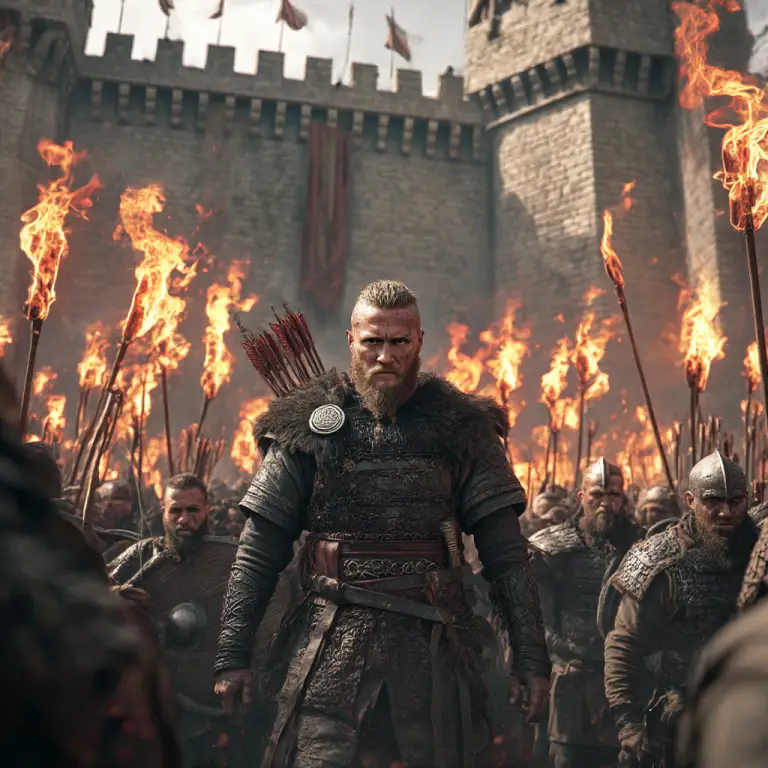The Vikings and the Siege of Paris – 845 AD
The Siege of Paris in 845 AD is one of the most dramatic and significant Viking raids on West Francia (modern-day France). Led by the legendary Viking chieftain Ragnar Lothbrok, this assault on the Frankish capital marked a turning point in Viking activity in continental Europe and showcased both the ferocity and tactical skill of Norse warriors.
Background
By the mid-9th century, Viking raids across Europe had intensified. These Norse seafarers, skilled in both navigation and warfare, had already targeted the British Isles and parts of mainland Europe. The wealth and political fragmentation of West Francia made it a prime target. Paris, positioned along the River Seine, was a prosperous and strategically important city.
The Viking Fleet
In 845, a fleet of approximately 120 longships carrying an estimated 5,000 Viking warriors sailed up the River Seine. These ships, shallow-draught and highly manoeuvrable, allowed the Vikings to travel far inland, striking at the heart of the Frankish realm.
The raid was allegedly led by Ragnar Lothbrok, a figure who exists somewhere between legend and history. Though his existence is debated, sources such as the Annals of Saint Bertin and Norse sagas associate him with the campaign. Ragnar’s bold leadership and the disciplined organisation of his forces gave the Vikings the advantage.
Assault on Paris
As the Vikings advanced, they plundered towns and monasteries along the Seine, instilling fear throughout the region. When they reached Paris, they launched a brutal siege. At that time, the city was relatively small, located on the Île de la Cité, a defensible island in the middle of the river.
The Frankish king, Charles the Bald, attempted to resist the incursion by gathering troops. He divided his forces on either side of the river to intercept the Vikings. However, the Norsemen attacked and overwhelmed one division, capturing and executing 111 Frankish soldiers in a gruesome show of force, reportedly hanging them in honour of the Norse god Odin.
Ransom and Retreat
Rather than risk further bloodshed and the destruction of Paris, Charles the Bald chose to negotiate. He paid the Vikings a substantial tribute of 7,000 livres (around 2,570 kilograms of silver) to persuade them to leave. This was one of the first large-scale Danegeld payments recorded in history – a practice that would become increasingly common as Viking raids continued.
After receiving the payment, Ragnar and his men withdrew, returning down the Seine with their spoils. The success of the siege and the substantial ransom only encouraged further Viking incursions in the years to come.
The Siege of Paris in 845 demonstrated the vulnerability of even the most important cities in Western Europe to Viking attack. It exposed the weaknesses of the Carolingian empire’s defences and set a precedent for the payment of Danegeld as a form of protection.
It also marked a significant moment in the legend of Ragnar Lothbrok, whose name would live on in Norse sagas and modern popular culture. While the historical accuracy of Ragnar’s role remains uncertain, his association with this bold and successful campaign has become part of Viking lore.
The siege also prompted the Franks to rethink their military strategies, eventually leading to the fortification of cities, construction of bridges, and other defensive reforms aimed at preventing future Viking success.
The Viking siege of Paris in 845 was not just a dramatic military event but a reflection of a changing Europe, where Norse seafarers emerged as both conquerors and settlers. It remains one of the most iconic moments of the Viking Age, symbolising the reach, ambition, and impact of the Norse world on medieval Europe.



